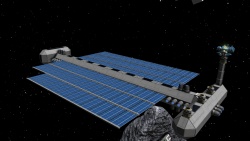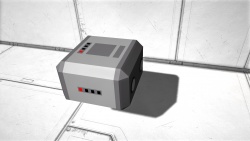电池
3,845,000,000 mg
3.845 t
12,000,000 W
12,000,000 W
3,000,000 Wh
10,800 MJ
10,800,000 kJ
10,800,000,000 J
1,040,400,000 mg
1.04 t
4,000,000 W
4,000,000 W
1,000,000 Wh
3,600 MJ
3,600,000 kJ
3,600,000,000 J
Overview
The battery is a single block that has a similar function to the reactors in that it will power blocks on a grid. It does not require any materials to be powered, and does come with a small intial charge but beyond this it must collect energy either from Solar panels, Large Reactors, and/or Small Reactors before it can be put to use (or even other batteries).
With Update 01.105, a battery, once built, already has a 30% charge, meaning it can be used immediately. However, it is now no longer possible to salvage Power Cells from a battery, any power cells will be recovered as Scrap Metal, losing a significant amount of Nickel and Silicon.
Usage
The battery is a convenient solution to saving/reserving power, and using no fuel that reactors for example would otherwise require. Or in the case of an incident, provide emergency power while repairs are made.
The battery block may be placed anywhere and unlike Reactors does not need to connected to a Conveyor network for refueling.
Control Panel
- Max Output - Maximum amount of power the battery can output to the grid
- Max Required Input - Maximum amount of power the battery can receive when in recharge state
- Max Stored Power - Maximum amount of power that can be stored on battery
- Current Input - The amount of power that the battery is currently drawing from the grid
- Current Output - The amount of power that the battery is currently providing to the grid
- Stored Power - The remaining amount of power that is stored within the battery
- Fully Depleted In - Time remaining till the battery is depleted of stored power
- Fully Charged In - Time remaining till the battery is fully charged.
Indicators
| Charge Mode | Toggle Block | |||
|---|---|---|---|---|
| Charged % | Auto | Recharge | Discharge | Off |
| 100% | |
|
|
|
| ≥75% | |
|
|
|
| ≥50% | |
|
|
|
| ≥25% | |
|
|
|
| >0% | |
|
|
|
| 0% | |
|
|
|
Recharging
Although a newly constructed battery will have some charge already available, providing power instantly once complete. The main purpose of the battery is to store and discharge power as needed. A ship may also recharge its battery through Connectors by drawing power from the other side while docked. This does not cost extra power. However, recharging from any source will only work at 80% efficiency rate which incurs a 20% penalty on recharging, meaning the block needs 20% more power for the amount of power returned to the grid.
Recharge Toggle
A Battery can recharge regardless of whether its Recharge setting is toggled or not, but if it's set to Recharge it will ONLY recharge and will not discharge or provide power. During this state, the battery will only draw power from the surrounding grid to store in its reserves. It will not discharge again till the player toggles "recharge" once again. Be aware that the charging process is not 100% efficient. Regardless of where the energy is coming from, only about 83.33% of the energy will actually be stored in the battery, the remainder being wasted due to an inherent inefficiency.
Discharge Toggle
Once a battery has enough charge in it it may be set to only discharge it's stored power into the grid, the battery should take priority over reactors (using fuel) but not active solar panels - this may vary due to subgrids and etc. A battery can discharge its stored power whether the it's discharge setting is toggled or not, but toggling the discharge means it will ONLY discharge and not at all draw power from other power sources such as other batteries or reactors.
When neither Discharge or Recharge is toggled
During this state which is the default state of a newly built battery, it will recharge automatically if there is any surplus power it can draw from and discharge automatically if there is a shortfall in power supply that is if there is more power being drawn that otherwise available without the battery's reserves. This is unwise as it may if Reactors are present quickly recharge and then discharge this stored energy, since the battery's charging is inefficient you essentially lose fuel in the process.
Semi-Auto Toggle
This mode will enable the battery to automatically recharge when at 0%, and then discharge when at 100%. In other words, it will automatically recharge and power the grid without player intervention.
Charging with Reactors
While reactors can recharge batteries, the efficiency is only about 80%, as noted above. Reactors due to high output can recharge the battery quickly, however this is considered very inefficient. Merely converting the stored energy in Uranium Ingots, to stored energy in batteries - which is not 1:1 conversion. Resulting in essentially losing 20% of the fuel in the process with inefficiency [3.60 MWh of Reactor output -> 3.00 MWh of Battery output after being fully charged].
Charging with Solar panels
While a single Solar Panel does not have the same power output as reactors, it is considered "free" energy since no fuel is spent to generate power. It will however be painfully slow with a single or a few panels being used and suffers the same efficiency penalty as do Reactors, a single large Solar Panel operating at peak effectiveness (160 kW160,000 W
While 30+ panels appears impractical to be built on a ship for a shorter recharge, its more logical to create such things as recharge satellites that your ships can dock with to recharge their batteries.
Power Output
Once charged, the battery can begin to power the grid it is placed on. It has nearly the same output capabilities as a small reactor with an output of 12 MW12,000,000 W
4,000,000 W
Media
Tips
- See Electricity for more information.
Known Issues
- Reactors charging a battery will not calculate their remaining fuel time correctly and will cause no fuel warnings.
- While the grid does correctly prioritize power sources for everything directly connected to it, once sub-grids (such as grids accessed through rotors, pistons, connectors, etc) also supply or draw power the battery can become confused. Such issues include:
- Batteries will charge and discharge at the same time as they attempt to run all system energy through them. This will lead to an automatic loss of fuel through inefficiency.
- Battery energy is not calculated as a part of a ship's energy output nor as part of its energy reserves.
- If energy use exceeds the output of solar panels, solar power will shut down entirely and all energy will be drawn from the battery.
Programming
Implements IMyBatteryBlock
Update History
| Update 01.105 |
|
Update 01.096 |
|
Update 01.041 |
|
Update 01.040 |
|
Update 01.039.010 |
|





